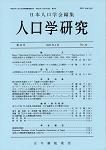Volume 22
Displaying 1-34 of 34 articles from this issue
- |<
- <
- 1
- >
- >|
Index
-
Article type: Cover
1998Volume 22 Pages Cover1-
Published: May 31, 1998
Released on J-STAGE: September 12, 2017
Download PDF (1342K) -
Article type: Index
1998Volume 22 Pages Toc1-
Published: May 31, 1998
Released on J-STAGE: September 12, 2017
Download PDF (1342K) -
Article type: Appendix
1998Volume 22 Pages App1-
Published: May 31, 1998
Released on J-STAGE: September 12, 2017
Download PDF (909K)
Article
-
Article type: Article
1998Volume 22 Pages 1-7
Published: May 31, 1998
Released on J-STAGE: September 12, 2017
Download PDF (1108K) -
Article type: Article
1998Volume 22 Pages 9-23
Published: May 31, 1998
Released on J-STAGE: September 12, 2017
Download PDF (2088K)
Note
-
Article type: Article
1998Volume 22 Pages 25-30
Published: May 31, 1998
Released on J-STAGE: September 12, 2017
Download PDF (895K)
Scientific Information
-
Article type: Article
1998Volume 22 Pages 31-37
Published: May 31, 1998
Released on J-STAGE: September 12, 2017
Download PDF (1306K)
Book Reviews
-
Article type: Article
1998Volume 22 Pages 39-
Published: May 31, 1998
Released on J-STAGE: September 12, 2017
Download PDF (244K) -
Article type: Article
1998Volume 22 Pages 39-
Published: May 31, 1998
Released on J-STAGE: September 12, 2017
Download PDF (244K) -
Article type: Appendix
1998Volume 22 Pages 39-
Published: May 31, 1998
Released on J-STAGE: September 12, 2017
Download PDF (148K)
PAJ Information
-
Article type: Article
1998Volume 22 Pages 40-
Published: May 31, 1998
Released on J-STAGE: September 12, 2017
Download PDF (245K) -
Article type: Article
1998Volume 22 Pages 40-
Published: May 31, 1998
Released on J-STAGE: September 12, 2017
Download PDF (245K) -
Article type: Article
1998Volume 22 Pages 40-
Published: May 31, 1998
Released on J-STAGE: September 12, 2017
Download PDF (245K) -
Article type: Article
1998Volume 22 Pages 40-41
Published: May 31, 1998
Released on J-STAGE: September 12, 2017
Download PDF (415K) -
Article type: Article
1998Volume 22 Pages 41-
Published: May 31, 1998
Released on J-STAGE: September 12, 2017
Download PDF (227K) -
Article type: Article
1998Volume 22 Pages 41-
Published: May 31, 1998
Released on J-STAGE: September 12, 2017
Download PDF (227K) -
Article type: Article
1998Volume 22 Pages 41-
Published: May 31, 1998
Released on J-STAGE: September 12, 2017
Download PDF (227K) -
Article type: Article
1998Volume 22 Pages 42-
Published: May 31, 1998
Released on J-STAGE: September 12, 2017
Download PDF (242K) -
Article type: Appendix
1998Volume 22 Pages 42-
Published: May 31, 1998
Released on J-STAGE: September 12, 2017
Download PDF (152K) -
Article type: Article
1998Volume 22 Pages 42-
Published: May 31, 1998
Released on J-STAGE: September 12, 2017
Download PDF (242K) -
Article type: Article
1998Volume 22 Pages 42-43
Published: May 31, 1998
Released on J-STAGE: September 12, 2017
Download PDF (421K) -
Article type: Article
1998Volume 22 Pages 43-
Published: May 31, 1998
Released on J-STAGE: September 12, 2017
Download PDF (232K) -
Article type: Article
1998Volume 22 Pages 43-
Published: May 31, 1998
Released on J-STAGE: September 12, 2017
Download PDF (232K) -
Article type: Article
1998Volume 22 Pages 43-
Published: May 31, 1998
Released on J-STAGE: September 12, 2017
Download PDF (232K) -
Article type: Appendix
1998Volume 22 Pages 44-
Published: May 31, 1998
Released on J-STAGE: September 12, 2017
Download PDF (92K) -
Article type: Appendix
1998Volume 22 Pages 45-51
Published: May 31, 1998
Released on J-STAGE: September 12, 2017
Download PDF (952K) -
Article type: Appendix
1998Volume 22 Pages 52-
Published: May 31, 1998
Released on J-STAGE: September 12, 2017
Download PDF (113K) -
Article type: Appendix
1998Volume 22 Pages 53-54
Published: May 31, 1998
Released on J-STAGE: September 12, 2017
Download PDF (183K) -
Article type: Appendix
1998Volume 22 Pages 55-
Published: May 31, 1998
Released on J-STAGE: September 12, 2017
Download PDF (69K) -
Article type: Appendix
1998Volume 22 Pages 55-
Published: May 31, 1998
Released on J-STAGE: September 12, 2017
Download PDF (69K) -
Article type: Appendix
1998Volume 22 Pages 56-
Published: May 31, 1998
Released on J-STAGE: September 12, 2017
Download PDF (38K) -
Article type: Appendix
1998Volume 22 Pages App2-
Published: May 31, 1998
Released on J-STAGE: September 12, 2017
Download PDF (909K) -
Article type: Cover
1998Volume 22 Pages Cover2-
Published: May 31, 1998
Released on J-STAGE: September 12, 2017
Download PDF (966K) -
Article type: Index
1998Volume 22 Pages Toc2-
Published: May 31, 1998
Released on J-STAGE: September 12, 2017
Download PDF (966K)
- |<
- <
- 1
- >
- >|
